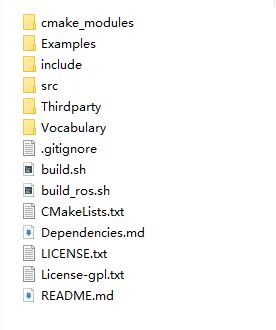ORB-SLAM2源码学习(一)——系统结构及System.cc
开始阅读学习ORB-SLAM2的源码了,在这里做个学习记录,另外也是督促自己的学习的更加深入。
前言
首先ORB-SLAM2作为一个完整的slam系统,作者即提供了论文也有对应的源码,它的github主页:
https://github.com/raulmur/ORB_SLAM2
系统包括了单目、双目、rgbd的实现,这里我主要学习单目slam系统,就以单目slam的流程来学习。
另外感谢泡泡机器人提供的有很好的注释版本(吴博):
https://gitee.com/paopaoslam/ORB-SLAM2
一、系统结构
ORB-SLAM2系统的代码非常整齐,简洁,便于阅读,作者将项目做了良好的封装,文件分布如下:
其中src中为slam系统源码,Examples中为对应不同传感器的例程源码,Thirdparty存放的是用到的第三方库,Vocabulary存放的是回环检测中BoW用到的视觉词典;
首先,我们看看怎么来调用ORB-SLAM2,学习一下例程源码mono_tum.cc。
二、mono_tum.cc(单目tum数据集例程)
主体源码,做过修剪:
int main(int argc, char **argv)
{
if(argc != 4)
{
cerr << endl << "Usage: ./mono_tum path_to_vocabulary path_to_settings path_to_sequence" << endl;
return 1;
}
// Retrieve paths to images
vector vstrImageFilenames;
vector vTimestamps;
string strFile = string(argv[3])+"/rgb.txt";
LoadImages(strFile, vstrImageFilenames, vTimestamps);
int nImages = vstrImageFilenames.size();
// Create SLAM system. It initializes all system threads and gets ready to process frames.
ORB_SLAM2::System SLAM(argv[1],argv[2],ORB_SLAM2::System::MONOCULAR,true);
// Vector for tracking time statistics
vector vTimesTrack;
vTimesTrack.resize(nImages);
cout << endl << "-------" << endl;
cout << "Start processing sequence ..." << endl;
cout << "Images in the sequence: " << nImages << endl << endl;
// Main loop
cv::Mat im;
for(int ni=0; ni >(t2 - t1).count();
vTimesTrack[ni]=ttrack;
// Wait to load the next frame
double T=0;
if(ni0)
T = tframe-vTimestamps[ni-1];
if(ttrack 可以看到使用ORB-SLAM2系统对外接口为下流程:
- 创建ORB_SLAM2::System对象
ORB_SLAM2::System SLAM(argv[1],argv[2],ORB_SLAM2::System::MONOCULAR,true); - 循环读取每一帧图片及其时间戳
SLAM.TrackMonocular(im,tframe); - 关闭SLAM系统
SLAM.Shutdown(); - 将相机轨线保存到硬盘中
SLAM.SaveKeyFrameTrajectoryTUM("KeyFrameTrajectory.txt");eg:在我第一次尝试使用编译好的mono_tum时,想要使用自己的数据来跑跑ORB-SLAM2,但因为没有考虑到文件时间戳问题(当时文件命名就是自然数),于是程序帧数几乎一秒一帧,可以看到上面的代码里有一段 usleep((T-ttrack)*1e6),这就是讲这个程序的运行速度和你提供的时间戳有关。
三、System.cc
在上面可以看到ORB-SLAM2系统的主入口通过System这个类定义的,这里来看下这个类的头文件。
class System
{
public:
// Input sensor
enum eSensor{
MONOCULAR=0,
STEREO=1,
RGBD=2
};
public:
// Initialize the SLAM system. It launches the Local Mapping, Loop Closing and Viewer threads.
System(const string &strVocFile, const string &strSettingsFile, const eSensor sensor, const bool bUseViewer = true);
// Proccess the given stereo frame. Images must be synchronized and rectified.
// Input images: RGB (CV_8UC3) or grayscale (CV_8U). RGB is converted to grayscale.
// Returns the camera pose (empty if tracking fails).
cv::Mat TrackStereo(const cv::Mat &imLeft, const cv::Mat &imRight, const double ×tamp);
// Process the given rgbd frame. Depthmap must be registered to the RGB frame.
// Input image: RGB (CV_8UC3) or grayscale (CV_8U). RGB is converted to grayscale.
// Input depthmap: Float (CV_32F).
// Returns the camera pose (empty if tracking fails).
cv::Mat TrackRGBD(const cv::Mat &im, const cv::Mat &depthmap, const double ×tamp);
// Proccess the given monocular frame
// Input images: RGB (CV_8UC3) or grayscale (CV_8U). RGB is converted to grayscale.
// Returns the camera pose (empty if tracking fails).
cv::Mat TrackMonocular(const cv::Mat &im, const double ×tamp);
// This stops local mapping thread (map building) and performs only camera tracking.
void ActivateLocalizationMode();
// This resumes local mapping thread and performs SLAM again.
void DeactivateLocalizationMode();
// Reset the system (clear map)
void Reset();
// All threads will be requested to finish.
// It waits until all threads have finished.
// This function must be called before saving the trajectory.
void Shutdown();
// Save camera trajectory in the TUM RGB-D dataset format.
// Only for stereo and RGB-D. This method does not work for monocular.
// Call first Shutdown()
// See format details at: http://vision.in.tum.de/data/datasets/rgbd-dataset
void SaveTrajectoryTUM(const string &filename);
// Save keyframe poses in the TUM RGB-D dataset format.
// This method works for all sensor input.
// Call first Shutdown()
// See format details at: http://vision.in.tum.de/data/datasets/rgbd-dataset
void SaveKeyFrameTrajectoryTUM(const string &filename);
// Save camera trajectory in the KITTI dataset format.
// Only for stereo and RGB-D. This method does not work for monocular.
// Call first Shutdown()
// See format details at: http://www.cvlibs.net/datasets/kitti/eval_odometry.php
void SaveTrajectoryKITTI(const string &filename);
// TODO: Save/Load functions
// SaveMap(const string &filename);
// LoadMap(const string &filename);
private:
// Input sensor
eSensor mSensor;
// ORB vocabulary used for place recognition and feature matching.
ORBVocabulary* mpVocabulary;
// KeyFrame database for place recognition (relocalization and loop detection).
KeyFrameDatabase* mpKeyFrameDatabase;
// Map structure that stores the pointers to all KeyFrames and MapPoints.
Map* mpMap;
// Tracker. It receives a frame and computes the associated camera pose.
// It also decides when to insert a new keyframe, create some new MapPoints and
// performs relocalization if tracking fails.
Tracking* mpTracker;
// Local Mapper. It manages the local map and performs local bundle adjustment.
LocalMapping* mpLocalMapper;
// Loop Closer. It searches loops with every new keyframe. If there is a loop it performs
// a pose graph optimization and full bundle adjustment (in a new thread) afterwards.
LoopClosing* mpLoopCloser;
// The viewer draws the map and the current camera pose. It uses Pangolin.
Viewer* mpViewer;
FrameDrawer* mpFrameDrawer;
MapDrawer* mpMapDrawer;
// System threads: Local Mapping, Loop Closing, Viewer.
// The Tracking thread "lives" in the main execution thread that creates the System object.
std::thread* mptLocalMapping;
std::thread* mptLoopClosing;
std::thread* mptViewer;
// Reset flag
std::mutex mMutexReset;
bool mbReset;
// Change mode flags
std::mutex mMutexMode;
bool mbActivateLocalizationMode;
bool mbDeactivateLocalizationMode;
};
类的成员有:
- ORB词袋的对象
- 关键帧的数据库对象
- 地图点数据对象
- Tracking对象
- Local Mapping对象
- Loop Closing对象
成员函数主要功能为:
- 构造函数初始化具体slam系统
- TrackMonocular将每一帧输入slam中进行处理
-
Shutdown停止slam线程
-
SaveKeyFrameTrajectoryTUM将关键帧位置做具体数据集格式的输出
接下来我们看看System.cc里的具体内容:
首先,System的构造函数里:
- 系统参数设置文件读取
- ORB词袋文件读取(txt或bin)
- 成员的初始化
-
LocalMapping、LoopClosing、Viewer线程直接启动(Tracking线程实际是主线程)
其次TrackMonocular函数里:调用了tracking的GrabImageMonocular函数对每一帧进行处理;这里就进入了tracking模块,在之后我们再来学习Tracking.cc。
最后在Shutdown函数里关闭LocalMapping、LoopClosing、Viewer线程。
